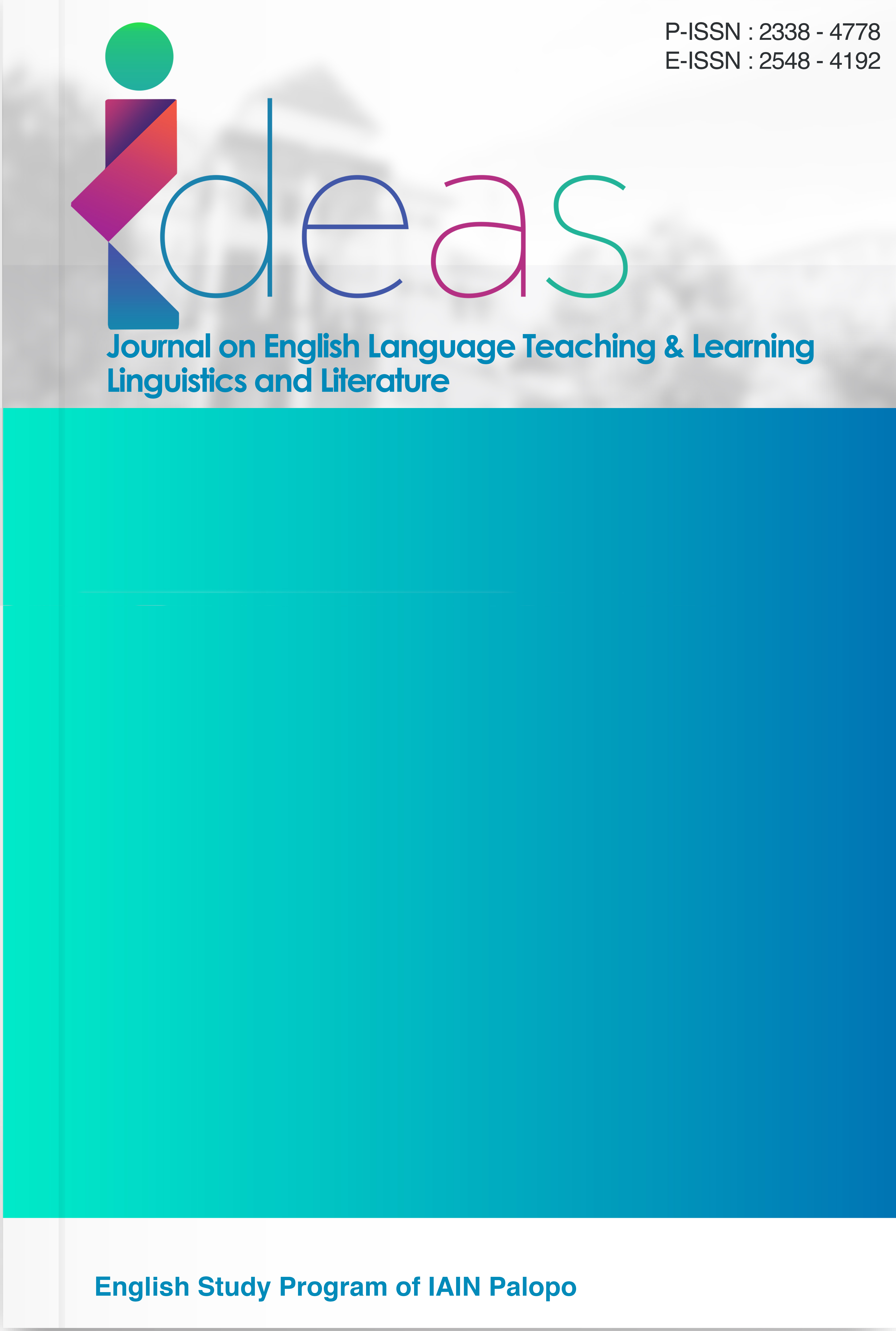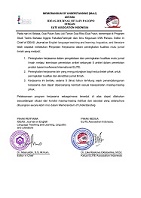Probing Digital Media Usage at State Islamic Colleges in North Sumatera; from Advantages to Challenges
DOI:
https://doi.org/10.24256/ideas.v13i2.5975Keywords:
Advantages, Challenges, Digital, Islamic Colleges, Media, Probing, UsageAbstract
Utilizing digital media platforms have been obligated for all educators including lecturers to face the educational development. However, there are still many lecturers who are not familiar with their advances and not ready with their usages in teaching. The objectives of this study are to see types of digital media platforms applied by the lecturers and to know advantages derived and challenges faced. The research was done with descriptive qualitative method and 13 English lecturers from the State Islamic Colleges in North Sumatera were chosen purposively as research respondents. To get the data needed, questionnaires were distributed, and interviews were done to respondents. To analyze the questionnaires data, the frequencies as well as percentages were counted, and data reduction, description, display, and conclusion were done to analyze interview data. This study found WA Group is the most preferred platform by the lecturers in blended learning followed by Google Meet, Zoom, Google Classroom, and Quizizz as well as Kahoot. Then, it is revealed that digital media help learners to have lots of interaction with peers and digital media also can motivate lecturers to develop their teaching professionalism. Finally, this research gives some contribution mostly to students and lecturers about types of digital media as well as the advantages of using digital media in teaching and learning process and it informs some challenges faced by students and teachers in making use of the digital media.
References
Aditiyawarman, M. A., Sondang, M., Hanifah, L., & Kusumayati, L. D. (2022). Penggunaan Aplikasi Quizizz Sebagai Media Untuk Melaksanakan Evaluasi Pembelajaran. Jurnal Penelitian, 7(1), 24–36. https://doi.org/10.46491/jp.v7i1.840
Anderson, T. (2019). Challenges and Opportunities for use of Social Media in Higher Education. Journal of Learning for Development, 6(1), 6–19. https://doi.org/10.56059/jl4d.v6i1.327
B, U. M., & Gani, I. P. (2023). Utilization of Digital Learning Media. https://doi.org/10.2991/978-2-494069-35-0
Bankov, A. S., Kuritsyna, G. V., Retivina, V. V., Rodkina, O. Y., & Chikova, N. D. (2021). Comfortable digital education: problems and development prospects. SHS Web of Conferences, 122, 03003. https://doi.org/10.1051/shsconf/202112203003
Buckingham, D. (2007). Media education goes digital: An introduction. Learning, Media and Technology, 32(2), 111–119. https://doi.org/10.1080/17439880701343006
Chew, E., Jones, N., & Turner, D. (2008). Critical review of the blended learning models based on Maslow’s and Vygotsky’s educational theory. Lecture Notes in Computer Science (Including Subseries Lecture Notes in Artificial Intelligence and Lecture Notes in Bioinformatics), 5169 LNCS, 40–53. https://doi.org/10.1007/978-3-540-85170-7_4
Dr Shaheen Parveen, & Shaikh Imran Ramzan. (2024). The Role of Digital Technologies in Education: Benefits and Challenges. International Research Journal on Advanced Engineering and Management (IRJAEM), 2(06), 2029–2037. https://doi.org/10.47392/irjaem.2024.0299
Diamantis, K. G. (2022). Inhibiting Factors in Teachers ’ Attempt to Use Digital Media in Everyday Inhibiting Factors in Teachers ’ Attempt to Use Digital Media in Everyday Teaching. (December).
Fadlilah, M. (2022). The Role of Digital Media in Language Learning for Blind Students at Junior High School. Proceedings of the Sixth International Conference on Language, Literature, Culture, and Education (ICOLLITE 2022), 304–307. https://doi.org/10.2991/978-2-494069-91-6_47
Fatira, M. A., Ferawati, Darmayani, S., Nendissa, S. J., Arifudin, O., Anggaraeni, F. D., … Handayani, F. S. (2021). Pembelajaran Digital. In Jurnal Refleksi Kepemimpinan (Vol. 3).
Haleem, A., Javaid, M., Asim, M., & Suman, R. (2022). Understanding the role of digital technologies in education : A review. Sustainable Operations and Computers, 3(May), 275–285. https://doi.org/10.1016/j.susoc.2022.05.004
Hikmah, D. (2019). Media For Language Teaching and Learning in Digital Era. International Journal of English Education and Linguistics (IJoEEL), 1(2), 36–41. https://doi.org/10.33650/ijoeel.v1i2.963
Klein, C. (2023). Understanding the Relevance of Digital Media in Higher Education. International Journal of Technology in Education and Science, 7(1), 71–82. https://doi.org/10.46328/ijtes.451
Ko, E. (2018). The Importance of Placing Digital Media in Education. International Journal of Media Culture and Literature, 2018(1), 37–46
Kuntari, S., & License, I. (2023). PROSIDING Vol.2 2023. 2, 90–94. https://doi.org/10.47435/sentikjar.v2i0.1826
Maeda, E. G., & Juma, Z. R. (2023). Challenges Facing Teachers in Using Digital Media in Teaching Literacy among Early Grade Pupils in Dodoma , Tanzania. 7(2021), 234–242
Masruddin, M., & Nasriandi, N. (2022). Lexical and Syntactical Errors Performed by Junior High School Student in Writing Descriptive Text. IDEAS: Journal on English Language Teaching and Learning, Linguistics and Literature, 10(1), 1094-1100.
Masruddin, M., Amir, F., Langaji, A., & Rusdiansyah, R. (2023). Conceptualizing linguistic politeness in light of age. International Journal of Society, Culture & Language, 11(3), 41-55.
Mahrani, K. H., Falatena, A., & Wahyunengsih, W. (2022). The Effectiveness of Learning Media Digitalization on Increasing Independent for Indonesian Millenial Learners. International Journal Pedagogy of Social Studies, 7(2), 1–8. https://doi.org/10.17509/ijposs.v7i2.51807
Mustafa, F., Nguyen, H. T. M., & Gao, X. (Andy). (2024). The challenges and solutions of technology integration in rural schools: A systematic literature review. International Journal of Educational Research, 126(May), 102380. https://doi.org/10.1016/j.ijer.2024.102380
Purba, Y., Madani, N. R., Darea, F. A., & Albana, A. S. (2021). PENGARUH PEMBELAJARAN DIGITAL DENGAN MODEL BLANDED POE2WE BAGI SISWA / MAHASISWA. 139–148.
Suganda, P. I. (2022). the Use of Digital Media To Improve Students’ Literacy in English Learning in Junior High School. Jurnal of English Development, 02(02), 99–108. Retrieved from https://doi.org/10.25217/jed.v2i01.2517
Sukaryanti, D., Nasution, F. N., Indria, S., & Hadi, W. (2021). Pentingnya Media Pembelajaran Digital dalam Mensukseskan Pembelajaran Bahasa Indonesia di Masa Pandemi. Prosiding Seminar Nasional PBSI-IV, 185–190.
Supeno, Darsono, Hadi Saputro, S., Nugraheni Sri Lestari, V., Suhaemi, I., Rodli, F., … Permatasari, F. (2019). Utilization of Whatsapp Application as Communication Media in Language Teaching and Learning at FBS UWKS. Journal of Physics: Conference Series, 1175(1). https://doi.org/10.1088/1742-6596/1175/1/012262
Suryani, N. (2016). Utilization of Digital Media to Improve The Quality and Attractiveness of The Teaching of History Nunuk Suryani. 2(1), 131–144.
Tristiana, N. E., & Kayyis, R. (2022). the Students Response of Using Google Classroom for Online Class. Jurnal Smart, 8(1), 19–27. https://doi.org/10.52657/js.v8i1.1609
Urai Salam, Wahdini, Surmiyati, Yanti Sri Rezeki, Dwi Riyanti, P. S. (2023). English Language Teaching Innovations and Materials. 5(1), 49–68.
Downloads
Published
Issue
Section
Citation Check
License
Copyright (c) 2025 Sokhira Linda Vinde Rambe, Yusni Sinaga

This work is licensed under a Creative Commons Attribution-ShareAlike 4.0 International License.
Authors retain copyright and grant the journal right of first publication with the work simultaneously licensed under an Attribution-ShareAlike 4.0 International (CC BY-SA 4.0) that allows others to share the work with an acknowledgement of the work's authorship and initial publication in this journal.
Authors are able to enter into separate, additional contractual arrangements for the non-exclusive distribution of the journal's published version of the work (e.g., post it to an institutional repository or publish it in a book), with an acknowledgement of its initial publication in this journal.
Authors are permitted and encouraged to post their work online (e.g., in institutional repositories or on their website) prior to and during the submission process, as it can lead to productive exchanges, as well as earlier and greater citation of published work (See the Effect of Open Access)




